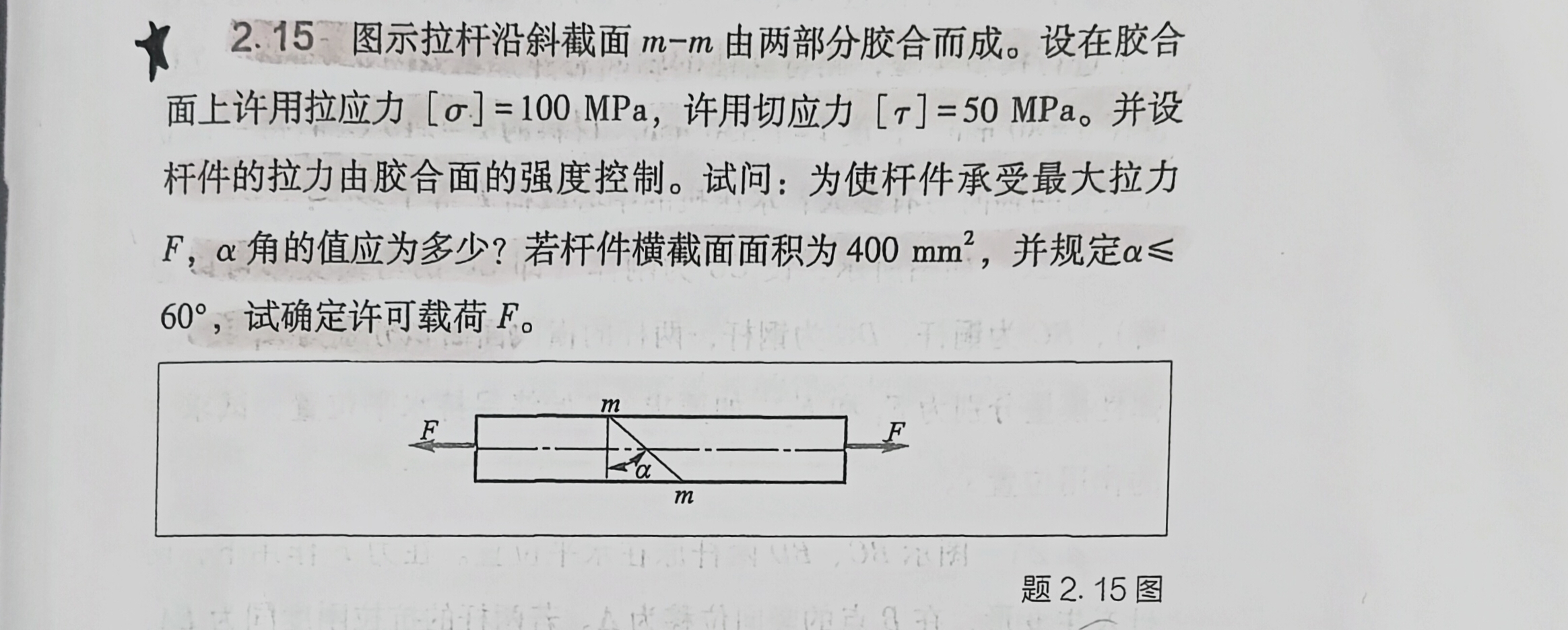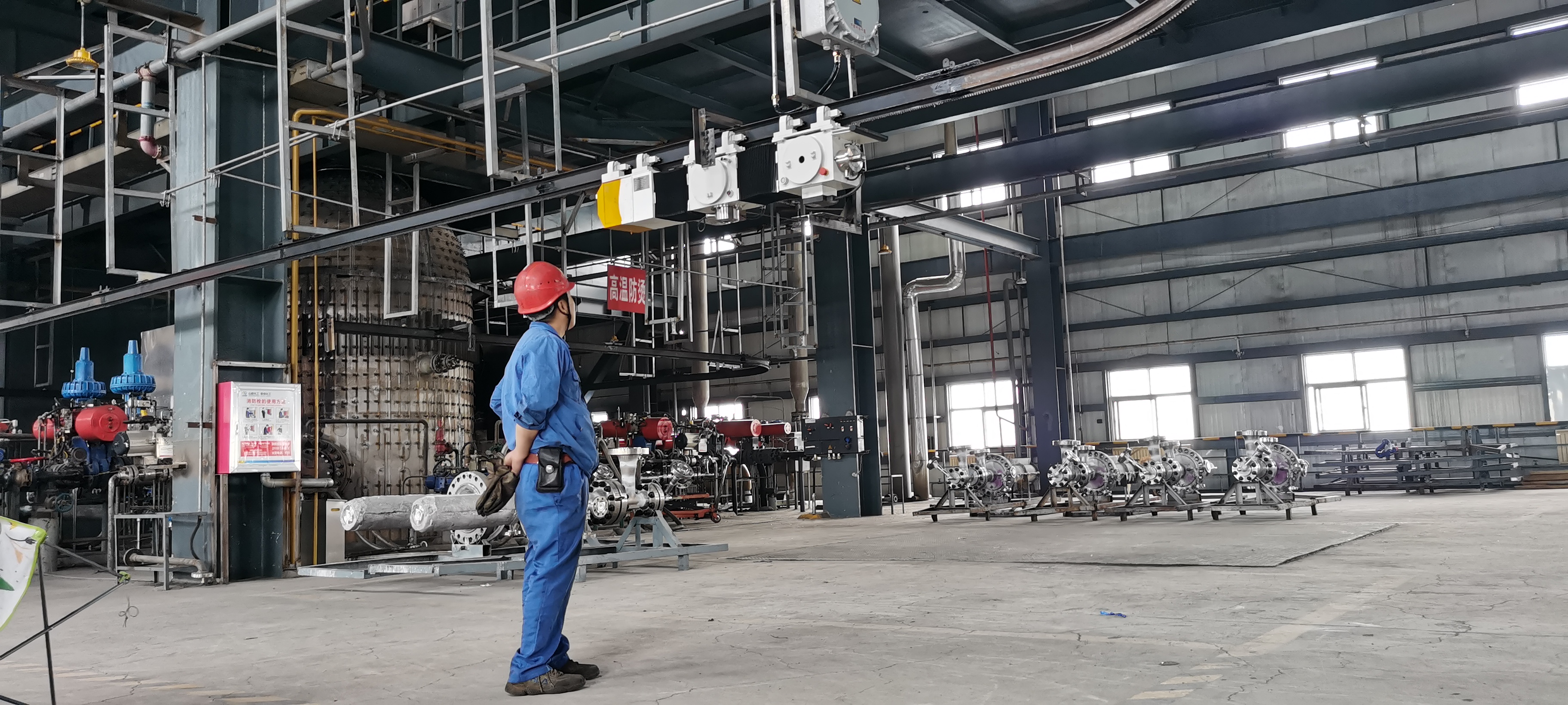杆件的拉伸与压缩
第一题
Q u e s t i o n \mathcal{Question} Question
图示拉杆沿斜截面 m − m m-m m−m由两部分胶合而成。设在胶合面上许用拉应力 [ σ ] = 100 MPa [\sigma]=100\text{MPa} [σ]=100MPa,许用切应力 [ τ ] = 50 MPa [\tau]=50\text{MPa} [τ]=50MPa。并设杆件的拉力由胶合面的强度控制。试问:
- 为使杆件承受最大拉力 F F F, α \alpha α角的值应为多少?
- 若杆件横截面面积为 400 mm 2 400\text{mm}^2 400mm2,并规定 α ≤ 6 0 ∘ \alpha\leq60^{\circ} α≤60∘,试确定许可载荷 F F F。

A n s w e r \mathcal{Answer} Answer
由拉伸杆斜截面上的应力公式:
σ
α
=
F
A
cos
2
α
\begin{equation} \sigma_{\alpha}=\dfrac{F}{A}\cos^2 \alpha \end{equation}
σα=AFcos2α
τ
α
=
F
A
sin
α
cos
α
\begin{equation} \tau_{\alpha}=\dfrac{F}{A}\sin\alpha\cos\alpha \end{equation}
τα=AFsinαcosα
该问题转化为以下最优化问题:
max
F
\max F
maxF
s.t.
{
σ
α
=
F
A
cos
2
α
≤
[
σ
]
τ
α
=
F
A
sin
α
cos
α
≤
[
τ
]
\begin{aligned} &\textbf{s.t.} \begin{cases} \sigma_{\alpha}=\dfrac{F}{A}\cos^{2}\alpha \leq [\sigma] \\ \tau_{\alpha}=\dfrac{F}{A}\sin\alpha\cos\alpha \leq [\tau] \end{cases} \end{aligned}
s.t.⎩
⎨
⎧σα=AFcos2α≤[σ]τα=AFsinαcosα≤[τ]
在问题一的背景下:
α 0 = arctan [ τ ] [ σ ] = 26. 6 ∘ \alpha_0=\arctan\dfrac{[\tau]}{[\sigma]}=26.6^{\circ} α0=arctan[σ][τ]=26.6∘
在问题二的背景下:
F max = A [ σ ] cos 2 α 0 = 50 kN F_{\max}=\dfrac{A[\sigma]}{\cos^2\alpha_0}=50\text{kN} Fmax=cos2α0A[σ]=50kN
第二题
Q
u
e
s
t
i
o
n
\mathcal{Question}
Question
重量为
W
W
W 的均质圆形等截面空心长钢杆,长度为
l
l
l,内径为
d
d
d,外径为
D
D
D。施工的某一过程中需要将其竖直悬吊于空中。若材料的弹性模量为
E
E
E,试求此时杆件在自重作用下的伸长量
Δ
l
\Delta l
Δl。

A
n
s
w
e
r
\mathcal{Answer}
Answer
取微元,其受轴力:
F
N
(
x
)
=
W
l
(
l
−
x
)
F_N(x)=\frac{W}{l}(l-x)
FN(x)=lW(l−x)
由胡克定律:
d ( δ l ) = F N d x E A \text{d}(\delta l)=\dfrac{F_{N}\text{d}x}{EA} d(δl)=EAFNdx
两边同时积分得到:
∫
L
d
(
δ
l
)
=
∫
0
l
F
N
d
x
E
A
\int_L\text{d}(\delta l)=\int_{0}^{l}\dfrac{F_{N}\text{d}x}{EA}
∫Ld(δl)=∫0lEAFNdx
故
Δ
l
=
2
l
W
E
π
(
D
2
−
d
2
)
\Delta l=\dfrac{2lW}{E\pi \left(D^2-d^2\right)}
Δl=Eπ(D2−d2)2lW
第三题
Q u e s t i o n \mathcal{Question} Question
在图示杆系中, B C BC BC和 B D BD BD两杆的材料相同,且抗拉和抗压许用应力相等,同为 [ σ ] [\sigma] [σ]。为使杆系使用的材料最省,试求夹角 θ \theta θ的值。

A n s w e r \mathcal{Answer} Answer
首先,分析
B
B
B 铰链的受力,根据平衡条件:
{
∑
F
x
=
0
,
F
N
2
−
F
N
1
cos
θ
=
0
∑
F
y
=
0
,
F
N
1
sin
θ
−
F
=
0
\begin{cases} \sum F_x = 0, & F_{N2} - F_{N1}\cos\theta = 0 \\ \sum F_y = 0, & F_{N1}\sin\theta - F = 0 \end{cases}
{∑Fx=0,∑Fy=0,FN2−FN1cosθ=0FN1sinθ−F=0
解上述两式可得:
F
N
1
=
F
sin
θ
,
F
N
2
=
F
cot
θ
F_{N1} = \frac{F}{\sin\theta}, \quad F_{N2} = F\cot\theta
FN1=sinθF,FN2=Fcotθ
最合理的情况是两杆同时达到许用应力值,即:
σ
1
=
F
N
1
A
1
=
[
σ
]
,
σ
2
=
F
N
2
A
2
=
[
σ
]
\sigma_1 = \frac{F_{N1}}{A_1} = [\sigma], \quad \sigma_2 = \frac{F_{N2}}{A_2} = [\sigma]
σ1=A1FN1=[σ],σ2=A2FN2=[σ]
将
F
N
1
F_{N1}
FN1、
F
N
2
F_{N2}
FN2 表达式代入上式,可得
B
D
BD
BD、
B
C
BC
BC 杆的截面面积分别为:
A
1
=
F
sin
θ
[
σ
]
,
A
2
=
F
cot
θ
[
σ
]
A_1 = \frac{F}{\sin\theta [\sigma]}, \quad A_2 = \frac{F\cot\theta}{[\sigma]}
A1=sinθ[σ]F,A2=[σ]Fcotθ
结构的体积为:
V
=
A
1
L
1
+
A
2
L
2
=
F
l
sin
θ
[
σ
]
cos
θ
+
F
l
cos
θ
sin
θ
[
σ
]
=
F
l
[
σ
]
(
1
+
cos
2
θ
sin
θ
cos
θ
)
=
F
l
[
σ
]
(
sin
2
θ
+
2
cos
2
θ
sin
θ
cos
θ
)
=
F
l
[
σ
]
(
tan
θ
+
2
cot
θ
)
\begin{align*} V &= A_1 L_1 + A_2 L_2 \\ &= \frac{Fl}{\sin\theta [\sigma] \cos\theta} + \frac{Fl\cos\theta}{\sin\theta [\sigma]} \\ &= \frac{Fl}{[\sigma]} \left( \frac{1 + \cos^2\theta}{\sin\theta \cos\theta} \right) \\ &= \frac{Fl}{[\sigma]} \left( \frac{\sin^2\theta + 2\cos^2\theta}{\sin\theta \cos\theta} \right) \\ &= \frac{Fl}{[\sigma]} (\tan\theta + 2\cot\theta) \end{align*}
V=A1L1+A2L2=sinθ[σ]cosθFl+sinθ[σ]Flcosθ=[σ]Fl(sinθcosθ1+cos2θ)=[σ]Fl(sinθcosθsin2θ+2cos2θ)=[σ]Fl(tanθ+2cotθ)
对体积
V
V
V 求导,体积最小的条件是:
d
V
d
θ
=
F
l
[
σ
]
(
1
cos
2
θ
−
2
sin
2
θ
)
=
F
l
[
σ
]
(
sin
2
θ
−
2
cos
2
θ
sin
2
θ
cos
2
θ
)
=
0
\frac{dV}{d\theta} = \frac{Fl}{[\sigma]} \left( \frac{1}{\cos^2\theta} - \frac{2}{\sin^2\theta} \right) = \frac{Fl}{[\sigma]} \left( \frac{\sin^2\theta - 2\cos^2\theta}{\sin^2\theta \cos^2\theta} \right) = 0
dθdV=[σ]Fl(cos2θ1−sin2θ2)=[σ]Fl(sin2θcos2θsin2θ−2cos2θ)=0
解上式得:
2
cos
2
θ
−
sin
2
θ
=
0
⟹
tan
2
θ
=
2
⟹
θ
=
54.
7
∘
2\cos^2\theta - \sin^2\theta = 0 \implies \tan^2\theta = 2 \implies \theta = 54.7^\circ
2cos2θ−sin2θ=0⟹tan2θ=2⟹θ=54.7∘
所以,使杆系使用材料最省的夹角为
θ
=
54.
7
∘
\theta = 54.7^\circ
θ=54.7∘。



















